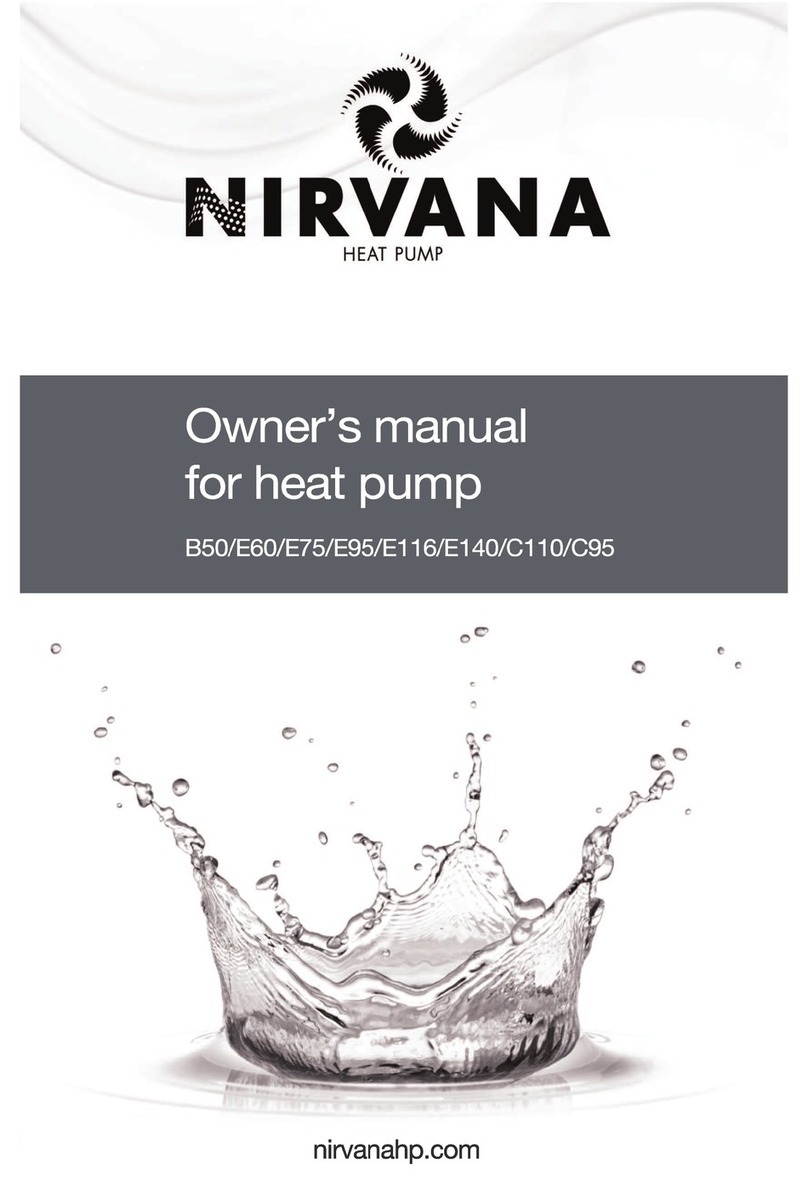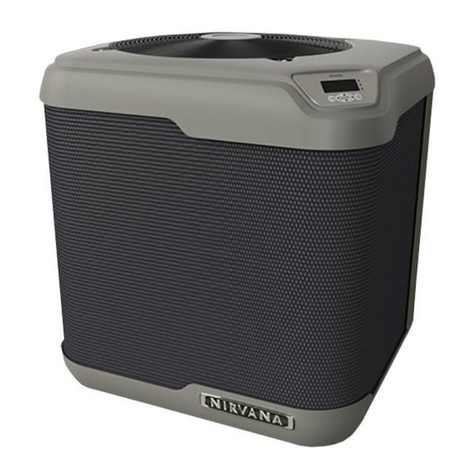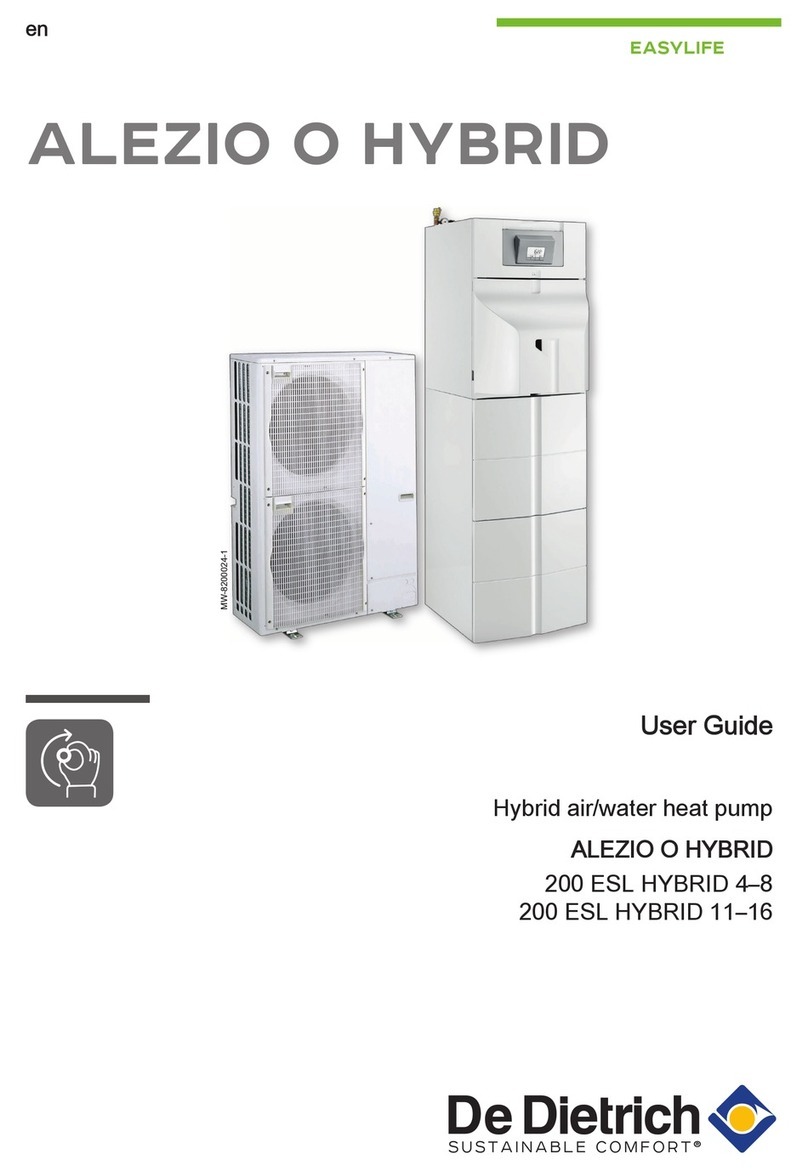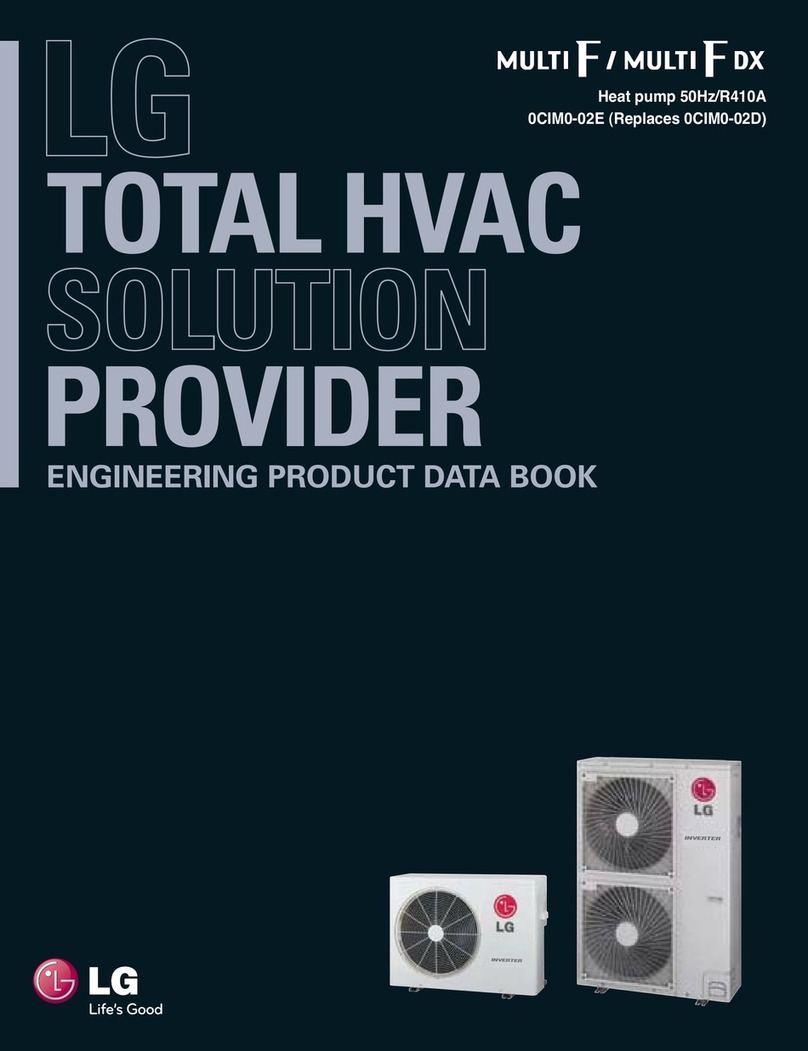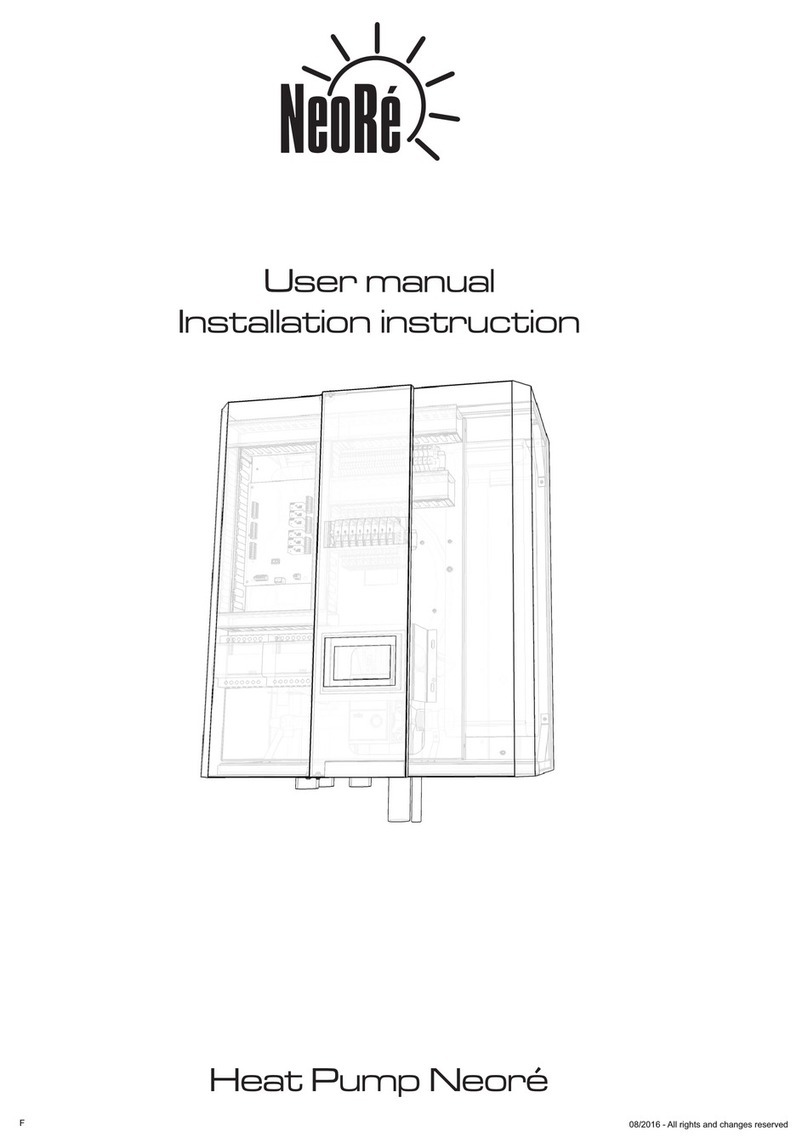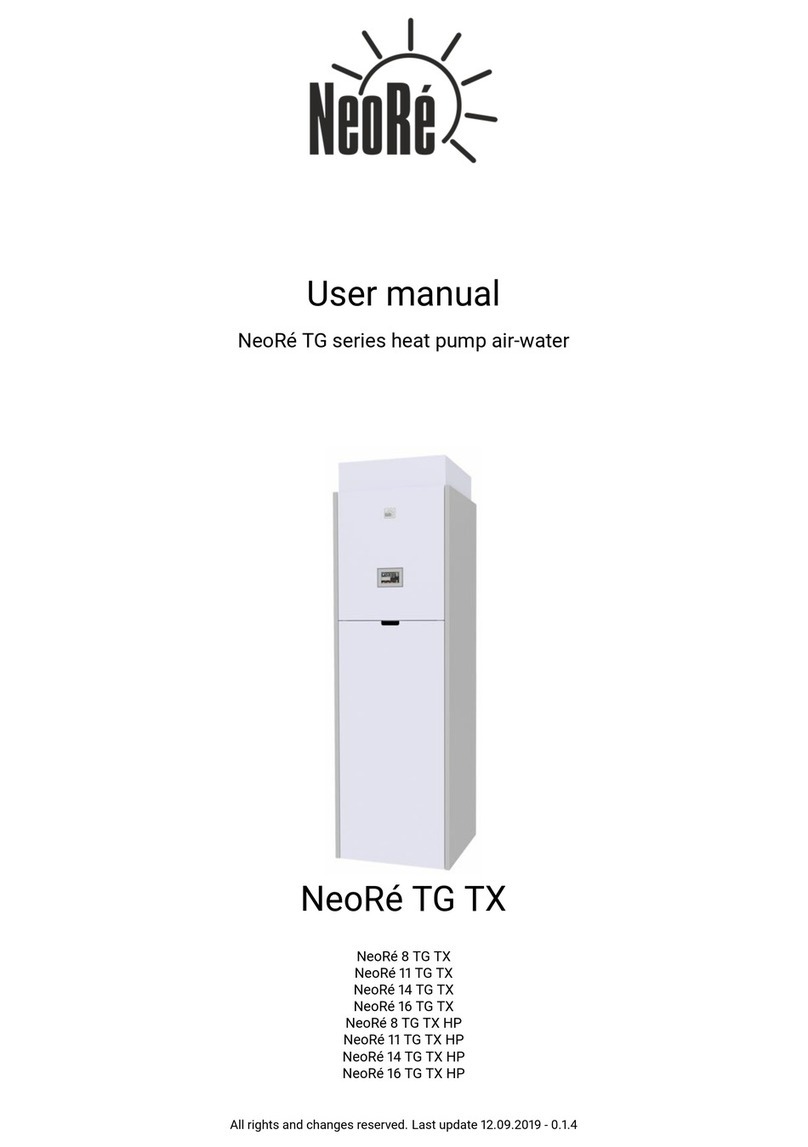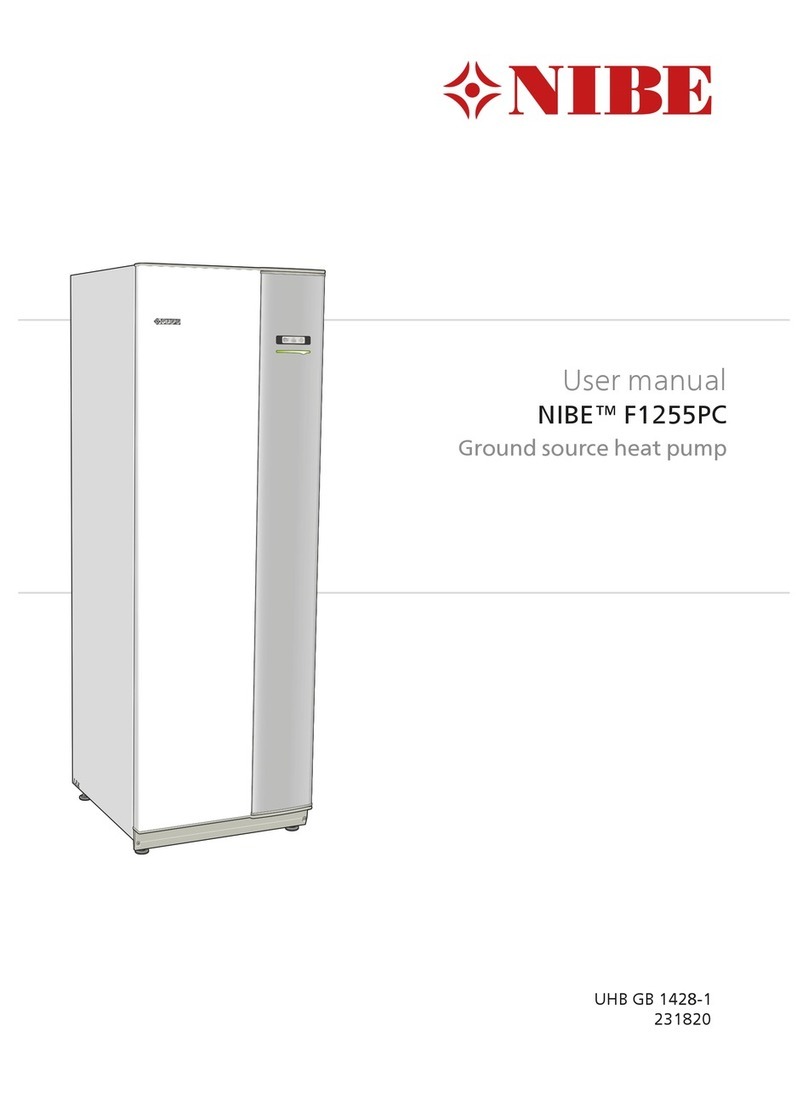Nirvana NE55 Service manual

SWIMMING POOL HEAT PUMP
Installation & Instruction Manual
IMPORTANT NOTE:
Thank you very much for purchasing our product. Before using your unit, please read
this manual carefully and keep it for future reference.


CONTENTS
SWIMMING POOL HEAT PUMP.................................................................................................................... 1
Installation & Instruction Manual ................................................................................................................ 1
1. FOREWORD....................................................................................................................................................... 1
1.1. Statement......................................................................................................................................... 1
1.2. Safety Factors ................................................................................................................................... 1
2. OVERVIEW OF THE UNIT................................................................................................................................... 3
2.1. Accessories Supplied with the Unit.................................................................................................. 3
2.2. Dimensions of the Unit..................................................................................................................... 3
2.3. Main Parts of the Unit...................................................................................................................... 4
2.4. SPECIFICATIONS................................................................................................................................ 5
3. INSTALLATION ................................................................................................................................................... 5
3.1. Transportation .................................................................................................................................. 6
3.2. Notice Before Installation................................................................................................................. 6
3.3. Installation Instructions.................................................................................................................... 6
3.3.1 Pre-requirements ........................................................................................................................ 7
3.3.2 Heat Pump Installation................................................................................................................ 7
3.3.3 Location and Size......................................................................................................................... 7
3.3.4 Installation Layout ....................................................................................................................... 8
3.3.5 Electrical Installation ................................................................................................................... 9
3.3.6 Electrical Connection................................................................................................................... 9
3.4. Commissioning the heat pump after Installation:............................................................................ 9
3.4.1 Inspection Before First Trial Run ............................................................................................... 10
3.4.2 Trial Run:....................................................................................................................................10
4. REMOTE CONTROLLER OPERATION GUIDANCE .............................................................................................10
4.1. Control Panel Diagram.................................................................................................................... 11
4.2. Key Operating Instructions............................................................................................................. 11
4.3. System Status .................................................................................................................................13
4.4. Trouble Shooting ............................................................................................................................14
5. MAINTENANCE AND WINTERIZING........................................................................................................15
5.1. Maintenance........................................................................................................................................15
5.2. Winterizing ..........................................................................................................................................15

1
1. FOREWORD
1.1. Statement
To keep users and property under safe operating conditions, please follow the instructions below:
①Wrong operation may result in injury or damage;
②Please install the unit in compliance with local laws, regulations and standards;
③Confirm power, voltage and frequency – NE55 Requires permanent 240Volt, 1 Phase, 60HZ
Connection;
④The unit must be permanently connected to the power supply by a qualified electrician
according to local rules and regulations.
⑤Independent power disconnect switch must be installed with the unit per local laws and
regulations.
1.2. Safety Factors
The following safety factors need to be considered:
①Please read the following warnings before installation.
②Be sure to check the details that need attention, including safety related warnings.
③After reading the installation instructions, be sure to save them for future reference.
Warning
Make sure that the unit is installed safely and is properly secured to a suitable base
⚫If the unit is not secured or installed properly, it may cause damage to the unit and
surrounding area.
⚫Unit must be installed outdoors in a well ventilated or open area.
①Use the correct gauge wire determined by an electrician per local regulations and fasten it to
the terminal block supported in a manner that there ensures no strain on the components or
wiring.
②Improper wiring may cause injury or fire.
Please connect power wire according to the wiring diagram in the manual to avoid fire or damage
to the unit.
③Be sure to use approved materials during installation. Wrong parts or wrong materials may
result in fire, electric shock, or the unit falling or tipping over.
④Install on the ground safely and properly secured, please read installation instructions.
Improper installation may result in fire, electric shock, tipping of the unit, or water leaking.
⑤Use professional tools for the electrical connections. If power supply capacity is insufficient
or circuit is not completed, it may cause fire or electric shock.
⑥The unit must have grounding device. If power supply does not have grounding device, do
not connect the unit.
⑦The unit should only be removed or repaired by a professional technician.
Improper movement or maintenance of the unit may cause water leakage, electric shock, or fire.
⑧Don't connect or disconnect unit without first disconnect the power at the breaker or power
disconnect. It may cause fire or electric shock.

2
⑨Don't touch or operate the unit when your hands are wet. It may cause fire or electric shock.
⑩Do not let water permeate into the electrical components.
Warning
①Do not install the unit in a location where there may be flammable gas.
②If there is flammable gas near the unit, it may cause an explosion.
③Do not clean the unit while power is on. Disconnect power at the circuit breaker before
cleaning the unit. Not disconnecting the power may result in injury from a running fan or electric
shock.
④Stop operating the unit when there is a problem or a fault code.
⑤Be careful when the unit is unpacked and not yet installed. Pay attention to sharp edges and
to the fins of the heat exchanger.
⑥After installation or repair, please confirm refrigerant is not leaking. If there is not enough
refrigerant, the unit will not work properly.
⑦Don’t put your fingers into fan or evaporator. Touching a running fan may result in serious
injury.
⑧This appliance is not to be used by persons (including children) with reduced physical,
sensory or mental capabilities, or lack of experience and knowledge, unless they have been given
supervision or instruction a professional technician. Children must use it under the supervision of
an adult to ensure that they use the appliance safely. If the power wire is damaged, it must be
replaced by a professional technician to avoid danger.

3
2. OVERVIEW OF THE UNIT
2.1. Accessories Supplied with the Unit
After unpacking, please check if you have all the following components.
NO.
Components
Quantity
NO.
Components
Quantity
①
User Manual
1
④
Drain Pipe
1
②
Rubber Blanket
4
⑤
Water Pipe Joint
2
③
Drain Connector
1
2.2. Dimensions of the Unit
Model: NE55

4
2.3. Main Parts of the Unit
1
Top cover
8
Front plate
15
Middle plate
2
Left handle
9
Fan motor cover
16
Pipe component
3
Motor support
10
Chassis
17
EEV
4
Left plate
11
Right plate
18
Fan motor
5
Fan blade
12
Wire controller
19
High efficiency finned heat exchanger
6
Fixed plate 1
13
Compressor
20
Electrical box
7
Fixed plate 2
14
Titanium heat exchanger
21
Back net

5
2.4. SPECIFICATIONS
Model
NE55
Power supply(V/Ph/Hz)
208-230V~/60Hz
Rated Ambient Temp Range (°F)
23~104
1Heating Capacity (Btu/h) –80/80/80
55000
1COP
6.0
2Heating Capacity (Btu/h) - 50/63/80
35000
2COP
4.0
Maximum Water Outlet Temp. (°F)
104
Rated Water Flow (gpm)
23.8
Rated Water Pressure Drop (psi)
3.77
Maximum Input Power (kBtu/h)
14.0
Fan Motor Rating Load (FLA) (A)
0.4
Fan Motor Horsepower (Hp)
1/8HP
Compressor Rated Load RLA (A)
15.7
Compressor Lock Rotor Amperage (LRA) (A)
86
Minimum Circuit Ampacity (A)
18.5
Breaker Size MIN/MAX (A)
20A/30A
Refrigerant Quantity (lbs)
R410A/3.417
Dry Weight (lbs)
134.5
Net Dimensions W×D×H (inches)
39.2×15.2×25.9
Water Pipe Connection
1.5 Inch Quick Connect
Water Proof Class
IPX4
Electricity Shock Proof Class
Ⅰ
Refrigerant Side Pressure Limits (psi)
638/217
Water Side Pressure Limits (psi)
100 psi
The technical specifications of our heat pumps are provided for information purposes only. We
reserve the right to make changes without notice.
3. INSTALLATION

6
3.1. Transportation
1. When storing or moving the heat pump, the heat pump should be in an upright position. Never
Tilt the unit more than 30 degrees
2.When moving the heat pump, do not lift it by the water unions as this may damage the titanium
heat exchanger inside the heat pump.
3.2. Notice Before Installation
1.The water unions are not designed to support the weight of unsupported flexible tubing. The
heat pump must be connected with properly supported tubing that does not pull or strain on the
heat pump unions!
2. To ensure heating efficiency, the length of the piping between the pool and the heat pump
should be less than 30ft.
3.3. Installation Instructions
WARNING: The heat pump must be installed by a qualified technician. Improper
installation, adjustment, service, maintenance or use can cause fire, electrical shock
or other conditions which may cause injury or property damage.
This section is provided for information purposes only and must be adapted according
to the actual site conditions.

7
3.3.1 Pre-requirements
Equipment necessary for the installation of your heat pump:
①Power supply cable suitable for the unit’s power requirements and compliant with your local
regulations.
②A By-Pass kit, sufficient PVC tubing suitable for your installation, as well as PVC , PVC
adhesive and sandpaper.
③A set of wall plugs and expansion screws suitable to attach the unit to your support or base.
④We recommend that you connect the unit to your installation by means of well supported
flexible PVC pipes to reduce the transmission of vibrations.
⑤Suitable fastening studs may be used to raise the unit.
3.3.2 Heat Pump Installation
①The heat pump must be fixed using bolts (M10) to a concrete foundation or suitable brackets.
The concrete foundation must be solid; the brackets must be strong enough and treated against
corrosion.
②The heat pump needs a water pump (Supplied by the user). Max. lift 30ft;
③When the heat pump is running, there will be condensate water discharged from the bottom
that must be properly managed and directed away from the heat pump. Please insert the drainage
tube (accessory) into the hole and clip it in properly, then connect a pipe to drain the condensate
water away. Install the heat pump, at least 3” off the ground with solid, water-resistant pads, then
connect the drainage pipe to the opening located under the heat pump.
3.3.3 Location and Size
Please comply with the following rules concerning the choice of heat pump location.
①The unit’s location must be easily accessible for convenient operation and maintenance.
②It must be installed on the ground, fixed ideally on a level concrete floor. Ensure that the floor
is sufficiently stable and can support the weight of the unit.
③A water drainage device must be provided close to the unit in order to protect the area where
it is installed.
④If necessary, the unit may be raised by using suitable mounting pads designed to support its
weight.
⑤Check that the unit is in a properly ventilated area, that the air outlet is not facing the windows
of neighboring buildings and that the exhaust air cannot return to the heat pump. In addition,
provide sufficient space around the unit for servicing and maintenance operations.
⑥The unit must not be installed in an area exposed to oil, flammable gases, corrosive products,
sulfur compounds or close to high frequency equipment.

8
⑦To prevent external damage to the unit, do not install it near a road or track.
⑧To avoid causing nuisance to neighbors, make sure the unit is installed in an area that is not
sensitive to noise.
⑨Keep the unit out of the reach of children.
⑩Installation space:
Unit: mm
Do not put anything less than 1500mm (5ft) in front of the heat pump.
Leave 500mm (2ft) of empty space on the sides and back of the heat pump and free space for
air circulation above
Do not leave any obstacles above or in front of the device!
3.3.4 Installation Layout
The installation diagram is shown in the following figure –
Pool → Pump → Filter → Heat Pump → Sanitizer → Return to Pool:
Notice: The filter must be cleaned regularly to ensure that water in the system is clean and to
avoid lack of water flow. It is necessary that a drainage valve is fixed at the lowest point in the
lower water pipe to completely drain water out of the system for winterizing. If the unit is not
No.
Item
Quantity
No.
Item
Quantity
1
Swimming Pump Unit
1
7
PH Regulator
1
2
Y-Type Filter
1
8
Sand Tank Filter
1
3
One-Way Valve
1
9
Flocculator
1
4
Circulating Water Pump
1
10
Disinfector
1
5
Hair Collector
1
11
Metering Pump
3
6
Stop Valve
7

9
running during winter months, please disconnect power supply and drain water from the unit
through the drainage valve or by disconnecting the quick connect fittings. If unit is used at ambient
temperatures below 0℃, please keep ensure that the water pump continuously runs to avoid
water freezing inside the machine.
3.3.5 Electrical Installation
To function safely and maintain the integrity of your electrical system, the unit must be connected
to your electrical supply in accordance with the following regulations:
①The heat pump must be connected to a suitable circuit breaker in accordance with current
standards and regulations in the country where the system is installed.
②The electrical supply cable must be adapted to match the unit’s rated power and the length
of wiring required for the installation. The cable must be suitable for outdoor use.
③In places open to the public, or where required by law, an emergency stop button or power
disconnect switch should be installed near the heat pump.
Power Supply Wire Size
Model
Power Supply Wires
Electrical Supply
Cable Diameter
Specification
NE55
208-230V~/60Hz
selected by electrician
selected by
electrician
3.3.6 Electrical Connection
WARNING: Power supply must be disconnected before performing any work on the heat
pump.
Please comply with the following instructions to connect the heat pump.
Step 1: Detach electrical side panel with a screwdriver to access electrical terminal block.
Step 2: Insert cable into the heat pump unit port.
Step 3: Connect power supply cable to terminal block according to the diagram below.
3.4. Commissioning the heat pump after Installation:
Note: If the water pump wattage is
more than 800 Watts, Do Not Connect
it to the terminal block inside the heat
pump. Use an external contactor, and
a separate breaker

10
WARNING: Please check all the wiring carefully before turning on the heat pump.
3.4.1 Inspection Before First Trial Run
Before performing initial functional test, confirm below items and write √ in block;
Correct unit installation
Power supply voltage is the same as unit rated voltage
Correct piping and wiring
Air inlet & outlet port of unit are unblocked
Drainage and venting are unblocked and there are no water
leaks
GFCI Breaker / Current Leakage protector are working (If
required by local regulations)
Ground wire / bonding wire are connected correctly
3.4.2 Trial Run:
Step 1: Run test can begin after completing the installation;
Step 2: All wiring and piping should be connected well and carefully checked, then start circulating
the water before power is switched on;
Step 3: Empty all air within the water circulation pipes, then press the “on-off” button on the control
panel to run the unit at the temperature setting;
Step 4: Items that need to be checked during the commissioning test:
①Check that unit current is normal per nameplate specifications;
②Check that each button on the control panel functions normally;
③Check that the screen is displaying information normally and that there are no error codes;
④Check for any water leaks in the circulation system;
⑤Check that the Condensate drain is not obstructed;
⑥Check for any abnormal sounds or vibrations?
⑦Check that heat pump shuts off on a water flow error as soon as the water pump is turned
off
4. REMOTE CONTROLLER OPERATION GUIDANCE

11
4.1. Control Panel Diagram
Basic Icons
①When in heating mode, " " light up;
②When in Cooling mode, " " light up;
③When in defrost mode, " " flash.
④When the unit is on, it displays an error code if an error is detected, and it displays water inlet
temperature if there are no errors.
⑤When the unit is off, it displays an error code if an error is detected, and it displays current
time if there are no errors.
4.2. Key Operating Instructions
No.
Item
Operation Way
1
ON/OFF
At the main interface, press " " to control system on / off.
2
Check System
Status
Pressing " " 5s to enter the system status query, with " " and "
" to query the system parameters.
3
Select Mode
In the start-on state, press " " to select mode between Heating mode,
Cooling mode, and Automatic mode.

12
No.
Item
Operation Way
4
Set Temperature
In the start-on state, press " " to decrease the temperature setting, and
press " " to increase the temperature setting.
5
Set Clock
Press " " on the main interface to enter the current time hour setting. The
hour part flashes. Press " " and " " to adjust the hour, then press "
" enter the current time minute setting. The digital minutes will flash. Press
" " and " " to adjust. Press " " or " " to exit after finishing the
time setting.
6
Time On
Press " " on the main interface to enter “time on” hour setting. The hour
part will flash. Press " " and " " to adjust. Then press " " to enter
the minute setting. The minute part will flash. Press " " and " " to
adjust. Press " " or " " to exit after completing the Time on setting.
7
Time Off
Press " " on the main interface to enter the “time off” hour setting. The hour
part will flash. Press " " and " " to adjust. Then press " " to enter
the minute setting. The minute part will flash. Press " " and " " to
adjust. Press " " or " " to exit after completing the Time Off setting.
8
Exit Interface
In other menus, press " " to exit and return to the main menu.
9
Fahrenheit /
Celsius Switch
In the shutdown state, press " " and " " 5s to switch °F / °C.

13
4.3. System Status
Code
Meaning
Range
Remarks
1
Water inlet temp.
-9~99℃ (16℉-210℉)
Measured
2
Water outlet temp.
-9~99℃ (16℉-210℉)
Measured
3
Coil temp.
-9~99℃ (16℉-210℉)
Measured
4
Exhaust temp.
0~125℃(0-257℉)
Measured
5
Ambient temp.
-9~99℃ (16℉-210℉)
Measured
6
Suction temp.
-9~99℃ (16℉-210℉)
Measured
7
Cooling coil Temp.
-9~99℃ (16℉-210℉)
Measured
8
EEV steps
0~48
Actual Value=10* Displayed Value

4.4. Trouble Shooting
Code
Description
Trouble shooting
P3
Water inlet temp. sensor failure
Check the sensor connection, change the sensor if necessary.
P4
Water outlet temp. sensor failure
Check the sensor connection, change the sensor if necessary.
P1
Coil temp. sensor failure
Check the sensor connection, change the sensor if necessary.
P7
Ambient temp. sensor failure
Check the sensor connection, change the sensor if necessary.
P2
Exhaust temp. sensor failure
Check the sensor connection, change the sensor if necessary.
P8
Excessive low temp. of water
outlet when cooling
No Action Needed, this is a protection feature and unit will
restart when necessary
E2
Excessive temperature difference
of water inlet and water outlet
protection
1. Replace exhaust temperature sensor.
2. Replace PCB control board.
3. HVAC Service Technician must check whether there is a
refrigerant system leak. If refrigerant leak is found, repair the
leak point, vacuum unit, then recharge the refrigerant
according to the type and weight of the refrigerant on the
nameplate.
PC
Winter level 1 frost protection
No User Action Needed, this is a protection function
PC
Winter level 2 frost protection
No User Action Needed, this is a protection function
E4
System high pressure failure
1. Check Water Flow. Clean the Pool filter
2. Check the inlet/outlet water temperature. Ensure heat
exchanger is not clogged.
3. Replace the high-pressure switch.
P9
System low pressure failure
1. Ambient temperature too low; <32f
2. Heat exchanger Dirty/Clogged. Carefully clean the fins.
3. Contact HVAC Service Tech as there might be a refrigerant
circuit blockage or refrigerant leak;
PL
Water flow failure
Check that there is Water Flowing through the Heat Pump.
Backwash / Clean Pool Filter
Check water flow switch, change the switch if necessary.
P6
Excessive temperature difference
between water inlet and water
outlet
Check whether the water flow meets the nameplate
requirements. Backwash / Clean Filter

Code
Description
Trouble shooting
E3
High exhaust temperature
protection
1. Replace exhaust temperature sensor.
2. Replace PCB control board.
3. Contact Service to Check for a refrigerant circuit leak. If
there is a refrigerant leak, repair the leak, vacuum unit, charge
the refrigerant according to the type and weight of the
refrigerant on the nameplate.
E8
Communication failure
(Available for remote controller ONLY)
1. Check if the communication connection wire between
display and PCB is well .
2. Change or mend the wire if necessary .
3. Check the PCB or display. If damaged, Change the
corresponding part .
E5
Cooling coil temp. sensor failure
Check the sensor connection, change the sensor if necessary.
E6
Suction temp. sensor failure
Check the sensor connection, change the sensor if necessary.
5. MAINTENANCE AND WINTERIZING
5.1. Maintenance
WARNING: Before undertaking maintenance work on the unit, ensure that you have
disconnected the electrical power supply.
1. Cleaning
a. The heat pump’s casing must be cleaned with a damp cloth. The use of detergents or other
household products could damage the surface of the casing and affect its properties.
b. The evaporator at the rear of the heat pump must be carefully cleaned with a vacuum cleaner
and soft brush attachment.
2. Annual maintenance
The following operations must be undertaken by a qualified person at least once a year.
a. Carry out safety checks.
b. Check the integrity of the electrical wiring.
c. Check the grounding/bonding connections.
d. Monitor the condition of the pressure gauge and the presence of refrigerant.
5.2. Winterizing
In winter season when you don’t swim:
a. Cut off power supply to prevent any machine damage.
b. Drain water out of the machine.
“CUT OFF” power supply to the heater
before cleaning, examination and repairs

c. Cover the machine body when not in use.
!! Important:
Unscrew the water inlet pipe fitting to let the water flow out of
the unit. If water freezes in the machine during the winter
season, the titanium heat exchanger may be damaged.

NIRVANA HEAT PUMP INC
4215 Rue St-Joseph
Trois-Rivieres, QC, G8Z 4G3
Tel Canada: (819) 519-8970
Tel USA: (844) 447-7665
www.nirvanahp.com
Table of contents
Other Nirvana Heat Pump manuals
Popular Heat Pump manuals by other brands

Haier
Haier AW07EH2VHA Service manual
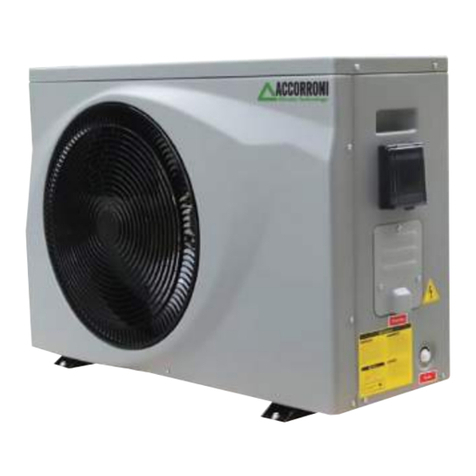
Accorroni
Accorroni TCPNS 701 Z manual

Thermal Zone
Thermal Zone Sea Breeze 9H49YIMI Installation and maintenance manual
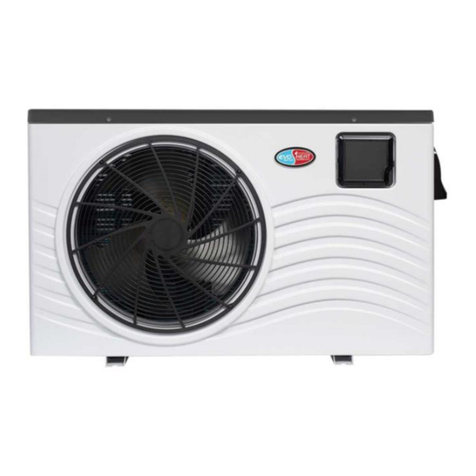
evoheat
evoheat Evo Fusion-i quick start guide

Bradford White
Bradford White AeroTherm Care and cleaning

Panasonic
Panasonic WH-SDC0509L3E5 operating instructions
